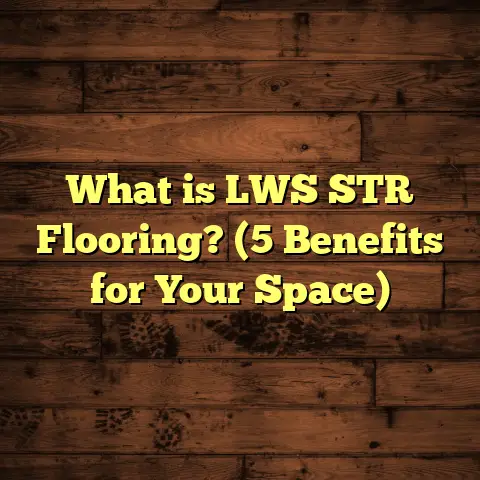What is Cast Stone Flooring? (5 Benefits You Can’t Ignore)
Imagine walking into a space where the floor beneath your feet feels sturdy, cool to the touch, and carries an undeniable sense of permanence. It’s a surface that doesn’t just support your every step but also enhances the entire vibe of the room with its rich texture and timeless look. This kind of floor tells a story — about craftsmanship, durability, and style — a story that I’ve come to appreciate deeply over years working with cast stone flooring.
When I first encountered cast stone flooring on a restoration project a decade ago, I was amazed by its ability to combine the beauty of natural stone with practical benefits that few other materials offer. It has since become one of my go-to recommendations for both residential and commercial clients who want something strong, stylish, and cost-effective.
If you’re curious about what cast stone flooring is and why it might be the best fit for your next project, I’m going to walk you through everything I’ve learned—from the basics to the advanced details. Ready? Let’s get started.
What is Cast Stone Flooring?
Cast stone flooring is a manufactured architectural concrete product designed to imitate natural stone. It’s created by mixing finely crushed natural stones (like limestone or quartz), cement, water, and sometimes pigments or additives to enhance color and finish. This mixture is poured into molds shaped like tiles or slabs and then cured to harden.
The result is a dense, durable surface that looks remarkably like quarried stone but offers greater control over consistency in color, texture, and size. Unlike natural stone that’s cut from large blocks, cast stone’s mold-based production allows for uniformity while replicating the intricate details found in nature.
What really sets cast stone apart is how adaptable it is. You can get it in many colors—from warm tans and browns to cool grays and blues—and you can choose textures ranging from smooth polished finishes to rougher, more rustic looks. In short, it’s a versatile flooring solution that can meet a wide range of design visions.
The Manufacturing Process — Why Does It Matter?
Understanding how cast stone is made sheds light on why it behaves so reliably in homes and commercial spaces. The crushed stone aggregate used is often sourced locally, reducing transportation costs and environmental impact. The cement acts as a binder, holding everything together.
Once mixed, the compound is poured into steel or rubber molds under vibration to remove air pockets and ensure density. After curing—sometimes accelerated using steam—the slabs or tiles are removed from molds and finished (polished or textured). This process allows manufacturers to embed pigments inside the material rather than just applying surface color like paint.
From a technical standpoint, this internal pigmentation means cast stone maintains its color even if the surface wears down slightly over time—unlike painted surfaces that can chip or fade.
How Cast Stone Differs from Other Stone-Like Flooring
You may have come across other stone-like options such as porcelain tiles designed to mimic marble or granite. While those offer great looks at times, they don’t match cast stone’s sheer mass and density.
Natural stones like granite or marble are mined in blocks and cut into slabs. This process gives them beautiful natural veining but also makes them more expensive and sometimes inconsistent in color and thickness. Moreover, some natural stones can be porous and require frequent sealing.
Cast stone bridges the gap by providing:
- Consistent quality: Uniform thickness and color options.
- Better durability: High compressive strength with low porosity.
- Customization: Ability to create custom shapes and sizes.
- Cost savings: Lower price than many natural stones.
5 Benefits of Cast Stone Flooring You Can’t Ignore
1. Durability That Stands the Test of Time
One thing I always tell people when we discuss flooring is, “It needs to last.” Floors take a beating—foot traffic, furniture movement, spills—you name it. Cast stone excels here because it’s engineered for strength.
Typical compressive strength for cast stone ranges between 6,000 psi to over 8,000 psi depending on the mix and curing process. For comparison:
| Material | Compressive Strength (psi) |
|---|---|
| Cast Stone | 6,000 – 8,000+ |
| Granite | 7,000 – 9,000 |
| Marble | 6,500 – 8,000 |
| Concrete (standard) | 3,000 – 4,000 |
This data shows cast stone holds its own against some of the toughest natural stones available.
In real-world terms, I’ve seen cast stone floors survive decades in commercial spaces like museums and shopping centers without cracking or significant wear. On one project at a community hall where over 200 people walked daily for five years straight, the floor maintained its integrity beautifully.
Resistance to freeze-thaw cycles also makes it suitable for outdoor patios in colder climates where other materials might crack or spall.
2. Design Flexibility That Lets You Get Creative
As someone who loves blending function with aesthetics, I appreciate how cast stone flooring opens doors for creative design without sacrificing practicality.
Because cast stone is molded rather than cut from blocks, you can customize:
- Shape: From simple squares to irregular cobblestone patterns.
- Size: Small tiles for intricate layouts or large slabs for seamless looks.
- Texture: Smooth polished surfaces or more tactile finishes.
- Color: A wide palette thanks to integral pigments added during mixing.
One project I worked on involved recreating a historic courtyard floor where the original cobblestone pattern was unique. Using custom molds, we replicated the exact pattern with cast stone at a fraction of what restoring natural stones would have cost.
Another client chose large-format slabs with subtle veining in shades of gray for their modern kitchen floor. The result was stunning—clean lines combined with natural-looking depth.
3. Budget-Friendly Without Compromising Quality
Let me be honest—natural stone floors can be beautiful but often come with sticker shock. The quarrying process, shipping heavy blocks long distances, cutting labor—all add up.
Cast stone gives you that same look and feel but usually costs 30% to 50% less than equivalent natural stones like travertine or marble.
Here’s a rough cost comparison per square foot based on recent market data:
| Flooring Type | Average Cost per Sq Ft (Installed) |
|---|---|
| Cast Stone | $15 – $30 |
| Marble | $40 – $70 |
| Granite | $35 – $60 |
| Porcelain Tile | $10 – $25 |
| Hardwood | $8 – $15 |
This means you can get durable, elegant floors without blowing your budget. One commercial client saved close to $25,000 by choosing cast stone instead of imported marble for their lobby renovation covering around 1,000 sq ft.
4. Easy Maintenance Saves You Time & Effort
Floors aren’t just about looks; they’re daily workhorses. Cast stone’s dense surface naturally resists stains better than porous stones like limestone or sandstone.
Maintenance involves simple regular cleaning:
- Sweeping or vacuuming to remove dirt.
- Mopping with mild detergent.
- Sealing every few years (depending on traffic) for extra protection.
I once consulted for a café owner frustrated by constant tile cracking and discoloration in their kitchen floors. After switching to cast stone flooring, their maintenance dropped significantly while the floor stayed looking fresh despite heavy daily use.
Another plus: cast stone’s surface provides good traction which reduces slip hazards even when wet—a nice safety benefit especially for families with kids or busy commercial kitchens.
5. Environmentally Friendly Flooring Choice
Sustainability matters more than ever when selecting building materials. Cast stone flooring can play a positive role here.
Since it uses locally sourced aggregates mixed with cement rather than mined large blocks shipped long distances:
- It reduces transportation emissions.
- Cuts down on quarry waste.
- Many manufacturers incorporate recycled materials into their mixes (e.g., crushed glass or recycled concrete).
For an eco-conscious client recently, we chose cast stone flooring because it helped them earn LEED certification points for their green building project due to its recycled content and durability (which means less frequent replacement).
How Cast Stone Flooring Fits Into Different Spaces
You might wonder where cast stone flooring works best. From my projects and observations:
Residential Spaces
Cast stone lends itself beautifully to indoor areas like:
- Entryways
- Kitchens
- Bathrooms
- Living rooms
- Sunrooms
Its durability stands up well against daily family life—pets running around, kids spilling juice—and it’s easy enough to clean after messes.
Outdoor patios and pool decks are also excellent candidates because cast stone handles weather well and prevents slipping when wet.
Commercial Spaces
High foot traffic areas like:
- Hotel lobbies
- Museums
- Retail stores
- Office buildings
- Restaurants
benefit from cast stone’s resilience. The ability to customize shapes and colors lets commercial designers create signature looks without sacrificing practicality.
In one museum installation I worked on covering 5,000 sq ft of gallery floor space — cast stone proved ideal because it could handle crowds while visually blending with historic architectural elements.
Installation Insights — What You Should Know
Installing cast stone flooring requires some skill but isn’t overly complicated if you hire experienced contractors.
Key points:
- Subfloor Preparation: Must be level and stable; improper preparation can cause cracking.
- Weight: Cast stone slabs can be heavy; handling requires care.
- Joints: Proper spacing ensures minimal visible seams yet allows for expansion.
- Adhesives & Grouting: Use recommended materials compatible with cast stone.
- Sealing: Essential after installation to protect against stains and moisture penetration.
- Radiant Heating Compatibility: Cast stone conducts heat well and pairs nicely with underfloor heating systems.
In my experience managing installation teams on various projects, attention to detail during this phase makes all the difference between a floor that lasts decades and one that needs early repair.
Comparing Cast Stone Flooring With Other Popular Options
Porcelain Tile
Porcelain offers great design variety but lacks the mass and durability of cast stone. Tiles are prone to chipping; grout lines may stain over time requiring maintenance cast stone often avoids due to larger slab sizes.
Hardwood Floors
Wood floors add warmth but scratch easily and dislike moisture exposure. Cast stone is more forgiving with spills or rough use while lending a cooler aesthetic that works well in certain climates or styles.
Natural Stone
Natural stones have unique beauty but higher costs plus variable maintenance needs (sealing frequency depends on porosity). Cast stone offers near-identical appearance with better uniformity and lower upkeep.
Troubleshooting Common Concerns About Cast Stone Floors
Some questions I hear often:
Does cast stone stain easily?
No. The dense material resists most stains better than porous stones. Regular sealing further reduces risk.
Can it crack?
Like any hard surface, improper installation or extreme structural movement can cause cracks but correctly installed cast stone floors are very stable.
Is it cold underfoot?
Yes compared to wood carpets etc., but pairing with radiant heating solves this comfortably.
Real-Life Case Studies Demonstrating Cast Stone Flooring Benefits
Boutique Hotel Lobby (3,000 sq ft)
The hotel wanted classic elegance without marble prices. We crafted custom gray-toned cast stone slabs with subtle veining matching their branding palette.
Outcome: Zero maintenance issues after 12 months; guests praised aesthetics; client saved nearly 40% vs marble quotes.
Riverside Restaurant Patio
Outdoor dining area used textured tan cast stone slabs mimicking sandstone cobbles.
Outcome: Floor resisted freeze-thaw damage through winters; easy cleanup after rainstorms; enhanced ambiance attracted more customers.
Community Arts Center Lobby
Heavy foot traffic called for a durable yet inviting floor. Polished light gray cast stone slabs provided modern look plus strength.
Outcome: Floor stayed crack-free after thousands of visitors; staff reported simple upkeep routines; overall satisfaction high.
Practical Tips Based on My Experience With Cast Stone Flooring
- Always work with trusted suppliers who provide detailed product specs.
- Confirm color samples before large orders—shades can vary slightly.
- Budget for sealing every few years—it protects investment.
- Consider larger slabs for fewer joints if you want sleek modern looks.
- If outdoors, check manufacturer’s recommendations for freeze resistance.
- Pair with radiant heating in cold climates for comfort.
- Use professional installers familiar with heavy slab handling techniques.
Design Trends Featuring Cast Stone Flooring
Cast stone adapts well across styles:
- Modern Minimalist: Large format gray slabs with matte finish provide clean lines.
- Rustic & Traditional: Cobblestone patterns or textured surfaces evoke old-world charm.
- Mediterranean Inspired: Warm terracotta hues blended with decorative borders.
- Industrial Chic: Neutral tones paired with exposed metal accents.
I’ve noticed increasing demand from designers wanting authentic-looking natural materials combined with durability for busy homes—cast stone fits perfectly here.
Environmental Impact & Sustainability Data
According to recent research from the Cement Sustainability Initiative:
- Cement production accounts for approximately 7% of global CO₂ emissions.
- Using locally sourced aggregates reduces transportation emissions significantly.
- Incorporating recycled content into cast stone mixes lowers raw material demand by up to 20%.
Manufacturers offering third-party certifications help verify these claims if eco-friendly building is a priority.
Final Thoughts From My Floor Contracting Journey
After years installing everything from hardwood to ceramic tile to luxury vinyl planks, cast stone flooring remains one of my favorites because it delivers on so many levels: beauty, strength, affordability, maintenance ease, and sustainability.
If you want floors that tell your space’s story through lasting style and function without endless upkeep headaches or high costs—cast stone deserves serious attention.
Got questions? I’m here anytime to share more insights based on my hands-on experience!





